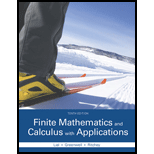
Concept explainers
Life Span As we saw in Exercise 62 of Section 17.2, researchers have estimated the maximum life span (in years) for various species of mammals according to the formula
where E is the average brain mass and P is the average body mass (both in g). Consider humans, with E = 14,100 g and P = 68,700 g. Find the approximate change in life span if the brain mass increases to 14,300 g and the body mass decreases to 68,400 g. Then calculate the actual change in life span and compare. Source: The Quarterly Review of Biology.
62. Life Span As we saw in the previous section, researchers have estimated the maximum life span (in years) for various species of mammals according to the formula
where E is the average brain mass and P is the average body mass (both in g). Find the approximate change in life span under the following conditions. Then calculate the actual change in life span and compare. Source: The Quarterly Review of Biology.
(a) The brain mass stays at 7.35 g, while the body mass goes from 150 g to 151 g.
(b) The body mass stays at 68,700g, while the brain mass goes from 14,100 g to 14,101 g.
Want to see the full answer?
Check out a sample textbook solution
Chapter 17 Solutions
Finite Mathematics and Calculus with Applications (10th Edition)
- Van der Waals Equation In Exercise 18 at the end of Section 2.3, we discussed the ideal gas law, which shows the relationship among volume V, pressure p, and temperature T for a fixed amount 1 mole of a gas. But chemists believe that in many situations, the van der Waals equation gives more accurate results. If we measure temperature T in kelvins, volume V in liters, and pressure p in atmosphere 1 atm is the pressure exerted by the atmosphere at sea level, then the relationship for carbon dioxide is given by p=0.082TV0.0433.592V2atm What volume does this equation predict for 1 mole of carbon dioxide at 500 kelvins and 100 atm?Suggestion: Consider volumes ranging from 0.1 to 1 liter.arrow_forwardDefine Newton’s Law of Cooling. Then name at least three real-world situations where Newton’s Law of Cooling would be applied.arrow_forward
 Functions and Change: A Modeling Approach to Coll...AlgebraISBN:9781337111348Author:Bruce Crauder, Benny Evans, Alan NoellPublisher:Cengage LearningAlgebra & Trigonometry with Analytic GeometryAlgebraISBN:9781133382119Author:SwokowskiPublisher:Cengage
Functions and Change: A Modeling Approach to Coll...AlgebraISBN:9781337111348Author:Bruce Crauder, Benny Evans, Alan NoellPublisher:Cengage LearningAlgebra & Trigonometry with Analytic GeometryAlgebraISBN:9781133382119Author:SwokowskiPublisher:Cengage Glencoe Algebra 1, Student Edition, 9780079039897...AlgebraISBN:9780079039897Author:CarterPublisher:McGraw Hill
Glencoe Algebra 1, Student Edition, 9780079039897...AlgebraISBN:9780079039897Author:CarterPublisher:McGraw Hill



